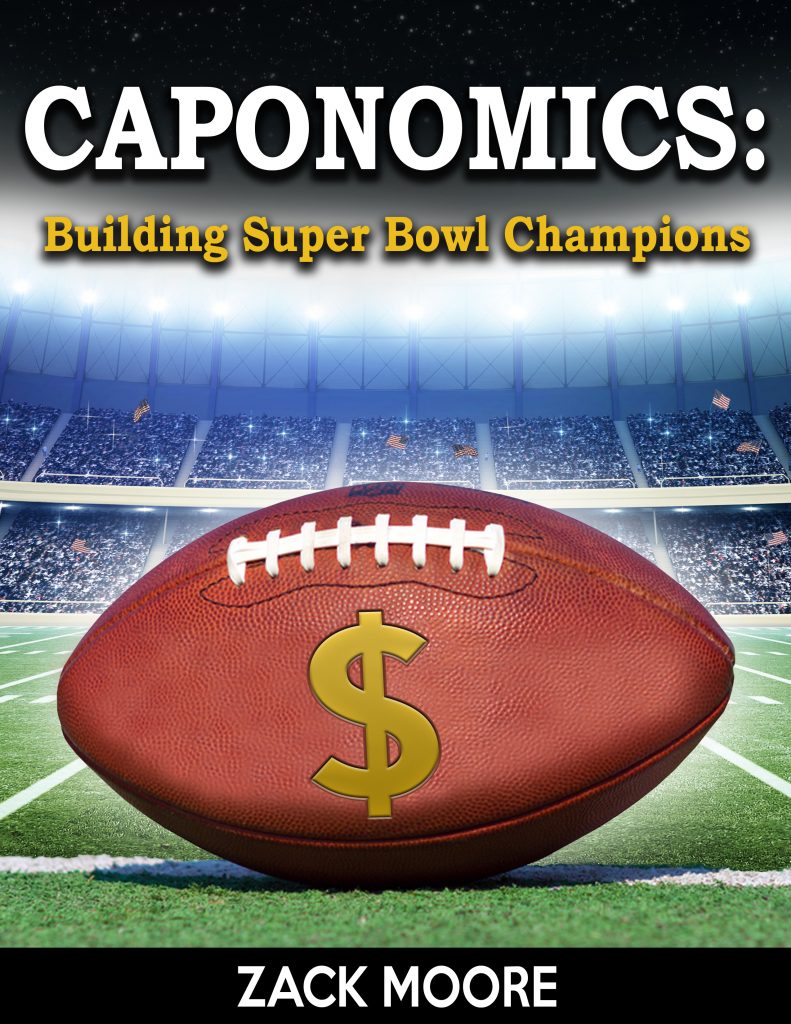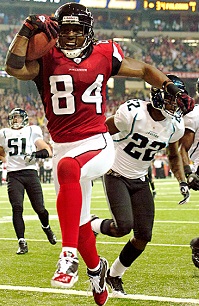Follow me on Twitter @BradOTC
While we are still a few months away from the 2020 NFL Draft, I wanted to get started on some preliminary Draft content before we hit Free Agency.
Knowing the relative Draft Capital of each team will also assist in your understanding of how Free Agency plays out. Teams will look to improve their roster through both avenues separately, but a cohesive plan that takes financial and positional considerations into account is vital to success.
What do I mean by Draft Capital? Simply, the Total Value of all Draft Picks for each team. Where am I getting the values of each pick? The Jimmy Johnson, Rich Hill and Jason Fitzgerald Draft Pick Value Charts.
Jimmy Johnson and Rich Hill effectively codified the NFL’s valuation of each draft pick based on previous draft pick trades (methodology explained here). Jason valued the draft picks based on the historical Second Contract outcomes of draft picks (methodology explained here). The Rich Hill rankings most closely resemble what NFL teams believe they have in Draft Capital. The Fitzgerald rankings most closely demonstrate what teams truly have in Draft Capital.
Here are Jimmy Johnson’s Chart Values:
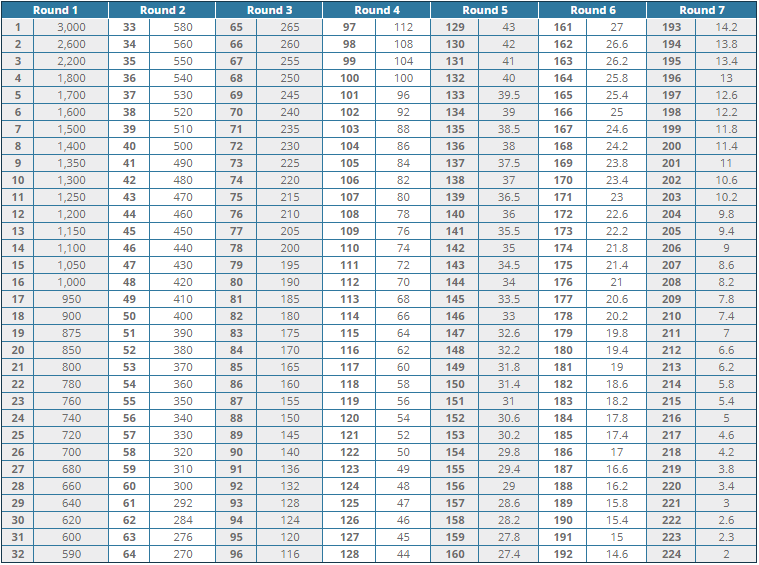
Here are Rich Hill’s Chart Values:

Finally, here is the Jason Fitzgerald Draft Value Chart:
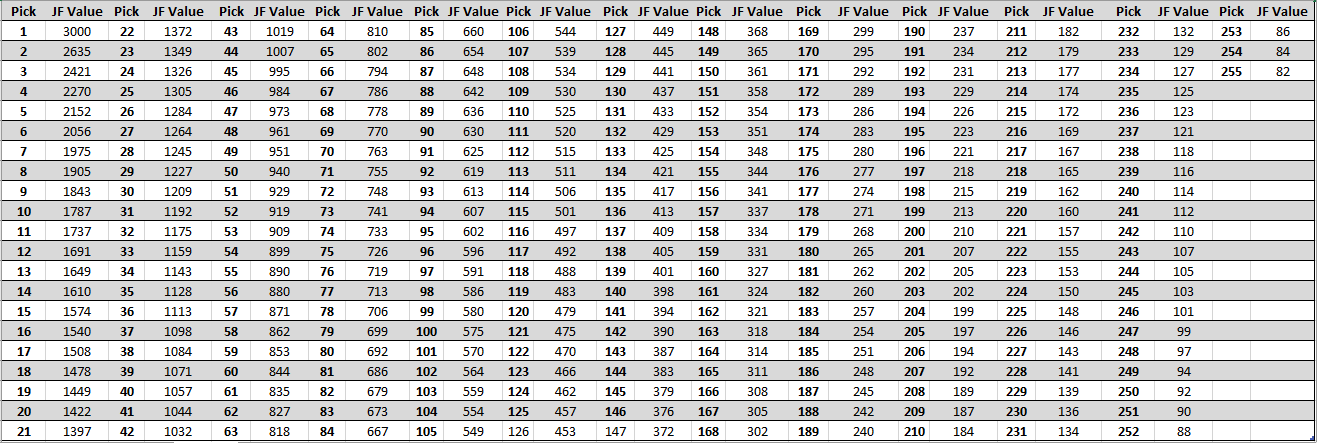
Let’s look at the Arizona Cardinals as an example. The Arizona Cardinals have the No. 8, No. 40, No. 72, No. 111, No. 153, and No. 222 Draft picks for 2020. You can find their Total Draft Capital by simply adding up the Values associated with those draft picks for each chart.
According to the Jimmy Johnson chart, Arizona has a Draft Capital of 2235 points. According to Rich Hill, Arizona has a Draft Capital of 662 points. Finally, according to Jason Fitzgerald’s chart, Arizona has a Draft Capital of 4736 points.
But what do these random numbers tell us? Not much without context. One way to make Draft Capital more approachable is to look at the Value as a percent of the Total Draft Pick Pool.
With 32 teams, an exactly equal distribution of all 256 Draft Picks would come out to 3.125% of the Draft Pick Pool per team. For the Jimmy Johnson chart, 2235 points is 3.68% of the Total Draft Pick Pool. So according to Jimmy Johnson, Arizona has slightly more Draft Capital than the average team. For Rich Hill, that percentage decreases slightly to 3.6%, but Arizona remains above average. Finally, for Jason Fitzgerald, that percentage moves across the 3.125% line to 3.09%. Jason’s chart believes Arizona has less Draft Capital than the standard average.
This approach still has its limitations, as each Draft is different. To take it one step further, how Arizona’s Draft Capital stacks up against the other teams in the league is the truly critical information.
The below table illustrates the 2020 Draft Capital for every team according to Jimmy Johnson, Rich Hill, and Jason Fitzgerald’s Draft Value Charts. The far right column shows the difference in perceived value between Rich Hill and Jason Fitzgerald.
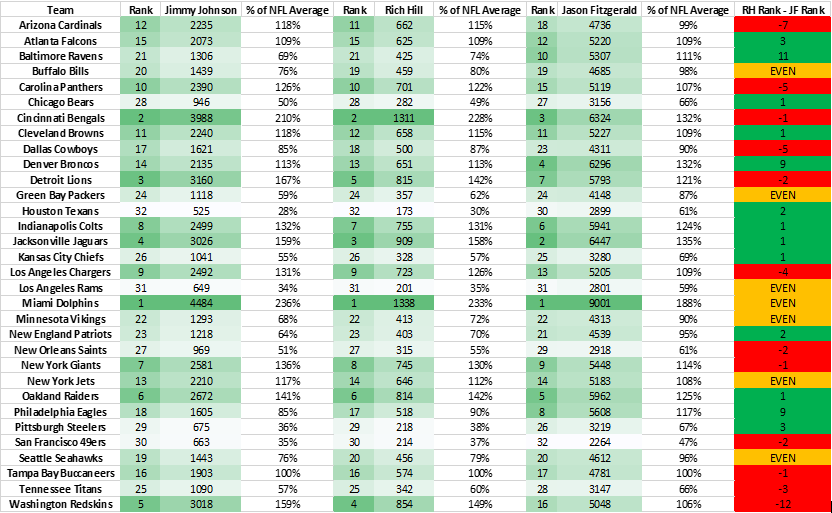
The above chart shows the 2020 Draft Capital for every team, including our Compensatory Pick guru Nick Korte’s projected compensatory picks for 2020.
Based on our analysis of every draft pick trade from 2011-2019, the Rich Hill Values most closely resemble what NFL teams are currently using to facilitate draft pick trades. The biggest disparities between Rich Hill’s chart and Jason Fitzgerald’s chart can largely be explained by the NFL overvaluing top draft picks and greatly undervaluing second and third round picks.
The Ravens (+11), Broncos (+9) and Eagles (+9) being the three teams that the Fitzgerald Chart valued the most as compared to the Rich Hill Chart is entirely unsurprising. The Ravens have earned the most compensatory picks of any franchise in the NFL since compensatory picks were created, and they trade down very often. The Broncos traded down from No. 10 to No. 20 with the Steelers just last year in a great trade for Denver in which they added a 2020 3rd Round pick. And the Eagles have embraced analytical decision-making in all facets of football as much or more than any other NFL team.
So what can we do with this information? Let’s take a look at 2019 Draft Capital before the Draft began…
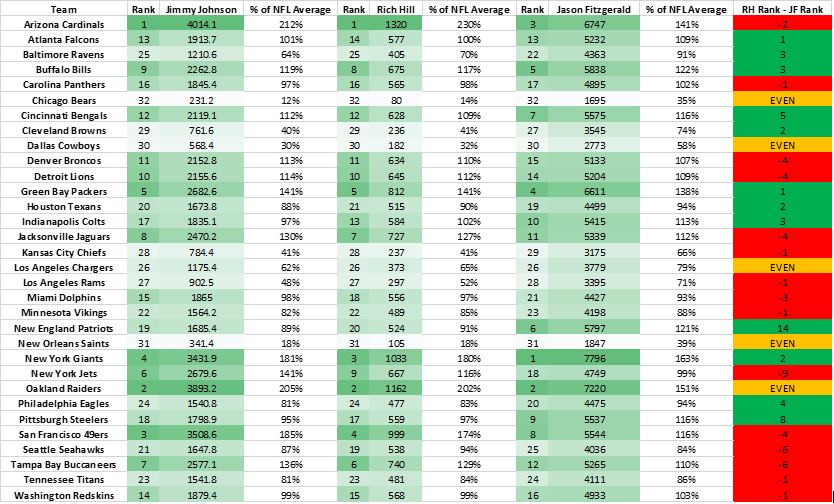
There were 37 “draft pick trades” (exclusively draft picks exchanging hands) during the 2019 NFL Draft. Another very unsurprising development: smart teams trade down a lot. It is no coincidence that the teams that traded down three or more times in 2019 were: the LA Rams, Minnesota Vikings, New England Patriots, Oakland Raiders and Seattle Seahawks. Now I know one of these is not like the other, but the Raiders maneuvered around the 2019 Draft exceptionally well.
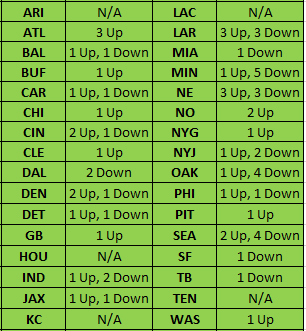
These trades obviously occurred all throughout the draft, and the amount of value exchanging hands for a trade in the 1st Round is a lot different than one in the 6th Round. Here is the breakdown of the Draft Value that teams Gained or Lost:

As noted before, these Values don’t mean much in a vacuum. So, I converted the values back into the respective Draft Pick they equate to on each chart. For example, as you can see above the Atlanta Falcons Lost 648 points with their 3 Trade-Ups according to the Jason Fitzgerald chart. 648 points on the Fitzgerald chart equates to the No. 87 overall pick. The Rich Hill chart has the Falcons Loss at 9 points, which equates to pick No. 164. In contrast, the Jimmy Johnson chart has the Falcons Gain 30.6 points, which equates to the No. 151 pick.
Here is the same 2019 Draft Pick Trade Summary chart as above, except with the Values as Draft Picks:
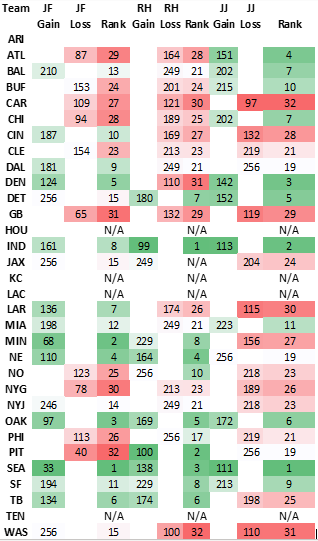
The Falcons example perfectly demonstrates the dangers of relying on the Jimmy Johnson Draft Pick Chart, which teams still appear to consult to varying degrees based on analysis of Draft Pick trades from 2011-2019. Calculating these Gains & Losses using the Values derived from Fitzgerald’s research of the historical outcomes of Draft Picks, the Falcons gave up a 3rd Round pick in Total Draft Capital through moving up three times. Calculating these Gains & Losses using an arbitrary point system with no known connection to data, the Falcons ADDED a 5th Round pick in Total Draft Capital according to the Jimmy Johnson chart. This disconnect can create tremendous value opportunities for smart teams, and it already has for some. Even when comparing Gains & Losses with the Rich Hill Chart (an update & improvement of the Jimmy Johnson Chart) there are still some large gaps in valuation.
The Falcons didn’t give up the most value according to the Fitzgerald chart though. That honor was reserved for the Pittsburgh Steelers, who made the biggest Trade-Up of 2019 from No. 20 (+ No. 52, + a 2020 3rd) to No. 10 to select Devin Bush. As you can see above, the Steelers clearly must at least look at the Jimmy Johnson Draft Value chart. I say this because according to the Jimmy Johnson chart, the Steelers and Broncos made a trade that was exactly equal in value for both parties. This is extremely rare for trades in the first two or three rounds. However, Jason Fitzgerald’s data tells us the Steelers gave up value equivalent to the No. 40 overall pick with the package they sent to Denver to move to No. 10. Rich Hill’s chart goes even further and actually tells the Steelers they won the trade and added value equivalent to the No. 100 overall pick. Imagine two NFL Draft war rooms wherein both teams thought they made out like absolute bandits in a trade. That is often the reality! The Jimmy Johnson & Rich Hill charts severely over-inflate the value of top picks and even more severely undervalue second and third round picks. That’s exactly what happened here.
One final component on display with the Steelers & Broncos trade that explains the large disparity: the future pick the Steelers included, a 2020 3rd. The analysis of trades from 2011-2019 seemed to confirm a long-held belief about perceived value in NFL Draft trades. The notion that when teams trade a future draft pick in the following year, they devalue the future pick by one round. For example, the 2020 3rd in this trade was treated as a mid-4th Round pick (No. 112) for the purposes of running this trade through the Johnson and/or Hill calculator to get as close to equal value as possible.
This methodology of devaluing future picks to the middle of the following round (No. 48, No. 80, No. 112, No. 144, No. 176, No. 208, No. 240) is imperfect for a few reasons, but still provided consistent results throughout the sample. First, teams don’t know if they will win the Super Bowl or have the No. 1 overall pick any given year (some may have better ideas than others over a stretch, but parity is real in the NFL). Second, compensatory picks make the length of the 3rd-7th Rounds different every year (Supplemental Draft pick usage can take a pick away from a team as well). Nevertheless, the Johnson and Hill charts have a much steeper decline in Draft Pick Value after the 1st Round than the Fitzgerald chart.
The “Rank” columns above really drive the point home: Jason Fitzgerald’s chart shows the Steelers gave up the most Draft Capital of anyone in 2019 through their big trade-up. Meanwhile, the Rich Hill chart tells the Steelers they added the second-most Draft Capital in the league. In their defense, and to play Devils Advocate a bit, if all of the other teams use the Jimmy Johnson and/or Rich Hill chart too then this isn’t that cut and dry. However, we know that the Fitzgerald Draft Values are based on actual data and are thus far more informative and predictive. For those that are fans of the Chase Stuart AV Draft Pick Value chart using Pro Football Reference’s Approximate Value metric, the Fitzgerald chart and Stuart chart are very similar.
On the opposite end of the spectrum, the Seahawks effectively added another 1st Round pick (No. 33 overall) with their series of Trade-Downs. The Seahawks traded back from their first spot of the night, No. 21 overall, and kept moving back to stockpile picks. Here is where every team started the Draft in terms of Draft Capital and where they stood by the end:
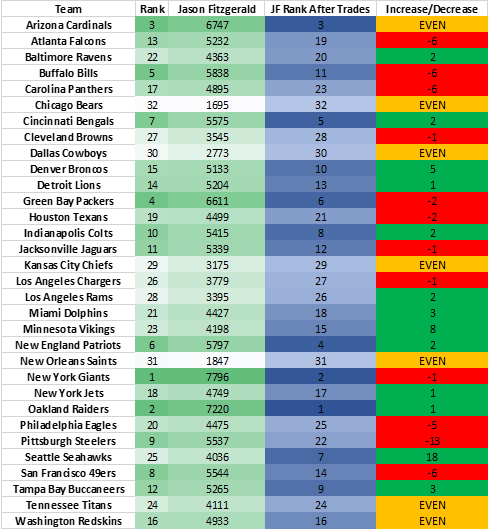
Future draft picks that were not accounted for in the Draft Capital before the Draft began were of course introduced, which makes this chart imperfect. But there aren’t many high priced future draft picks (especially when you devalue them all by a round) exchanging hands in a given Draft, so the impact is not too large. The Seahawks started the Draft with the 25th-most Draft Capital according to Jason Fitzgerald and ended it with the 7th-most, and they didn’t acquire any future picks. So within the 2019 Draft itself, the Seahawks were able to go from the bottom-third to the top-third in Draft Capital. How do you have a winning record for eight straight seasons? Well, there’s part of your answer.
I will be updating the 2020 Draft Capital as trades unfold throughout the offseason until the NFL Draft on April 23rd.
By: Brad Spielberger (@BradOTC)
